Mid-Summer Crop Management
BY Dairyland Seed Agronomy Team
CORN ROOTWORM SCOUTING REMINDERS
Corn rootworm (CRW) larvae and adults cause severe damage to corn every year. Western corn rootworm and Northern corn rootworm are the two species that cause the most economic damage to corn across the Midwest. Corn rootworm adult beetles are starting to appear in corn fields around early July, so now is a great time to get scouting on your radar. It is important to determine if populations are present and, at what severity, to help with management decisions and to predict future problems.
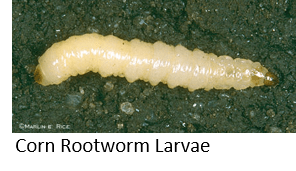 |
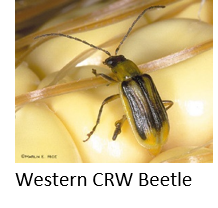 |
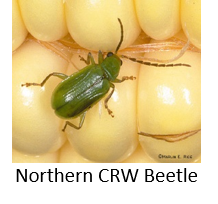 |
Lifecycle
- CRW larvae emerge from late May to mid-June and feed on corn roots. The most extensive damage is done to the corn crop during this time.
- Plants with damaged roots are more likely to show excessive drought stress, nutrient deficiencies and lodging.
- Adult emergence begins in early to mid-July and they remain active through September. Adult beetles will lay eggs which overwinter into the next growing season. The best time to scout for adult beetles is post silking.
- Adult CRW interfere with pollination and may reduce kernel set. They feed on silks, pollen, leaves and kernels.
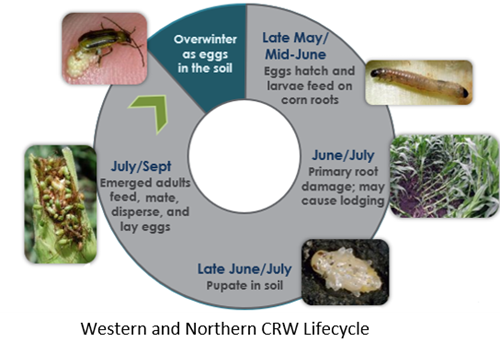
Scouting
- During pollination, watch for silk feeding. If silks are clipped back to less than a half inch during pollination, then treatment should be considered.
- Watch for adult beetles on the corn plant and consider treatment if the number of beetles averages 0.75 per plant or higher.
- Inspect corn roots for signs of larval feeding, ideally from mid-July to mid-August.
- Pruned roots will appear ragged and off color while healthy roots are white.
- The NIS rating system is commonly used to assess damage. A root node is considered pruned if it is less than 1.5 inches long. The score is determined by the number of pruned root nodes. For example, 1.75 is one pruned root node pruned and another is 75 percent pruned. An NIS score of greater than 0.75 typically leads to economic loss.
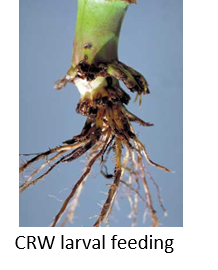
Management Options
- Rotate crops and avoid corn-on-corn
- Extend the rotation so corn is every three years in areas with the variant Western CRW and extended diapause in Northern CRW.
- Use hybrids that contain traits to control CRW.
- Use a seed applied insecticide or granular insecticide at planting.
- Use a foliar insecticide, if thresholds are met, to control adult females before they lay eggs.
DEALING WITH SATURATED SOILS?
It appears it has been feast, or famine when it comes to moisture patterns for 2021. This is especially true as you move to the east towards Illinois and Indiana some locales have received 5 plus inches of rain in the last few days. Conversely, as you move to the west to Minnesota and into North and South Dakota, areas have received some moisture, but are still very dry in many areas and are in need of more rainfall to get a crop.
The power of water is amazing. Its recuperative nature can cause a wilted plant to uncurl its leaves or straighten up a stem. Its destructive nature can cause erosion or flooding. An acre inch of water or 1 inch of water per acre is 27,154.3 gallons. If you put or receive 1 inch of water on 40 acres that is over 1 million gallons of water and if you receive that on 160 acres, it is over 4.3 million gallons of water.
|
1 Inch of Water per acre = 27,154 gallons of water |
|
40 Acres X 27,154 gallons = 1,086,160 gallons of water |
On average, a corn plant will utilize 3,000 to 5,000 gallons of water per bushel. If a typical corn yield is 200 bushels/acre, it would take 600,000 to 1,000,000,000 gallons of water to produce that crop. Soybeans will use 400,000 to 700,000 gallons of water to produce a crop.
Water use requirements vary by crop growth stage for both corn and soybeans. A rule of thumb commonly used for both corn and soybeans is:
|
Growth Stage |
Average water use rate (in/day) |
|
Vegetative |
.10-.20 |
|
Reproductive |
.20-.30 |
|
Late Reproductive |
.05-.20 |
Since we are in the late vegetative growth stage for corn and early reproductive stage for soybeans, we will use .2 inches of water per day, which will result in 1.4 inches of water per week.
|
.2 Inch of Water/Day * 7 Days = 1.4 Inches of Water/Week |
|
1.4 of Water/Week * 27,154 Gallon/Acre Inch = 38,015 Gallons |
|
38,015 Gallons * 40 Acres = 1,520,624 Gallon |
With large amounts of precipitation can come crop responses that can be concerning. When soils are saturated, the oxygen levels in the soil decrease and areas of ponding or flooding can be completely depleted of oxygen in one or two days. Oxygen in the soil is crucial for root growth, nutrient uptake and respiration.
Saturated soil conditions are when the roots are flooded and complete submergence is when the entire plant is underwater.
- Saturated soil conditions are not as detrimental as complete submergence. In areas of ponding or flooding deoxygenation can happen quicky depending on temperature, humidity and cloud cover.
- Crops that are submerged for up to two days should see new regrowth in 3 to 5 days after the water recedes.
- Crops that have been under both of these water stressors will exhibit similar symptoms such as drooping, curling, and cupping of leaves and as we have discussed in previous articles the plants may appear to be pale or yellow.
If you have any concerns about your crop that has experienced these events contact your Dairyland Seed DSM or Regional Agronomist.
MID-SUMMER ALFALFA EVALUATION
While much of the Dairyland Seed territory received some desperately-needed rainfall in the past week, there are still areas to watch the rest of the summer to make sure you have the yield and quality needed for 2021 and beyond.
- Increase cutting height to reduce potential soil contamination and elevate forage quality.
- Proactively monitor chopped forage to be sure it’s going into storage at an adequate moisture. Too dry will negatively affect fermentation and stability leading to dry matter loss and decreased animal performance if fed.
- Beware the risk of nitrate poisoning if your stand contains a mix of grasses. All forage should be tested prior to feeding, but especially when harvested in less-than-ideal conditions.
- Know your animal numbers, forage inventory, and usage rates to determine if you’re going to need to purchase ahead of the winter months. If so, prices are likely to increase as Fall approaches so secure what is necessary ahead of time.
- Spring-seeded alfalfa stands will struggle with limited moisture. If late-summer planting conditions are right, increasing the stand density may be a great option. Look for sparse germination, slow initial growth or regrowth after cutting, and pressure from weeds or insects to determine the full extent of lost yield.
- Scouting for pests will be important to reduce immediate damage, identify the appropriate response, and get the crop back on track for the next cutting. Dry conditions magnified alfalfa weevil injury on fields where first cutting was delayed which then stretched into second cutting regrowth. Luckily, weevils are cooler weather insects and extended destruction from them will be minimal. Now we need to turn our attention to other yield-robbers by sweeping and subsequently treating where insect infestations exceed the economic threshold for that particular pest. You can rely on your agronomist for help identifying the bug and the best approach for control.
SHOW OFF YOUR FIELDS WITH DAIRYLAND SEED FIELD SIGNS
Signing your fields is a great way to promote Dairyland Seed products in your area. Field signs for corn, soybeans and alfalfa can be ordered by calling the Dairyland Seed headquarters at 800-236-0163 and ask to speak with Stacy Hendricks or Rita Frank.
CORTEVA TECHNOLOGY USE AGREEMENTS
All growers with orders for any Corteva Agriscience brand seed product, regardless of crop or trait (including non-GMO products) need to have a signed Corteva Technology Use Agreement in place by September 1. Growers should sign the Corteva Technology Use Agreement electronically at www.agcelerate.com. Signing electronically is preferable, however, paper copies are available at www.traitstewardship.com or by calling Rita Frank in the Dairyland Seed West Bend office at 800-236-0163.
 |
 |
 |
 |
 |
| Brian Weller Western Region 507.456.3034 |
Dan Ritter Central Region 219.863.0583 |
Branden Furseth Northern Region 608.513.4265 |
Mark Gibson Eastern Region 260.330.8968 |
Amanda Goffnett Eastern Region 989.400.3793 |
